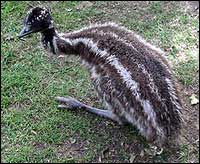Animal Facts
Emu
(
Dromaius novaehollandiae )
Description
 The
emu is the largest bird in Australia, and the second largest in the
world after the ostrich.
The
emu is the largest bird in Australia, and the second largest in the
world after the ostrich.
Emus have long necks, sharp beaks and small ears. They have two sets of eyelids, one for blinking and one to keep out the dust. Their feet are long, with three toes. One toe on each foot has a long talon, for fighting.
Emu feathers are soft and light-brown with dark tips. Each feather has a double shaft.
Emus can grow to between 5 to 6.5 feet (1.5 – 2 metres) in height and weigh up to 130 pounds (60 kg). Males are slightly smaller than females. Males make a grunting sound like a pig and females make a loud booming sound.
Habitat and history
Emus are found only in Australia. They live in most of the less-populated areas of the continent and although they can survive in most regions, they avoid dense forest and severe desert.
Emus have been living in Australia for a very long time. Their ancestors, the Dromornithids, roamed the land when dinosaurs lived. Originally there were three species of emu, but now there is only one. The two other species became extinct because they were hunted for their meat and feathers.
Family
The emu belongs to a family of flightless birds called Ratites. Most Ratites are now extinct, and only the emu, ostrich, cassowary, kiwi and rhea are alive today.
Biology
Other flightless birds have a keel on their sternum, but Ratites do not. This means that Ratites don’t have a strong anchor for their wing muscles, so they couldn’t fly even if they developed suitable wings. Emus have tiny wings hidden under their feathers. They hold them out as stabilizers when they run.
Emus must drink every day, and they don’t waste water. On very hot days they breathe rapidly, using their lungs as evaporative coolers. Their large nasal passages have multiple folds inside. In cooler weather they use these folds to recycle air and create moisture for reuse.
Breeding
Emus pair in summer and breed in the cooler months. The female develops blue skin on her neck and her feathers turn a darker brown. She struts around the male making special noises to say that she is ready to mate.
The male builds a rough nest from bark, grass, sticks and leaves, in a hollow on the ground. Every second or third day, the female lays a very large, thick-shelled, dark green egg, weighing about 1 pound (0.5 kg). The male becomes broody after about the seventh egg. He sits on the clutch of eggs to incubate them, in between the times when the female lays more eggs. Nests usually have clutches of 8 to 10 eggs, but there can be almost double this number.
For the next eight weeks, the male stays on the nest, surviving on his accumulated body fat and any morning dew that he can reach. He stands up only to turn the eggs, about 10 times a day. Despite his efforts, goannas, eagles and hawks attack the eggs.
Emu chicks
 Emu chicks are active as soon as they hatch, and can leave the
nest within a few days. They stand about 10 inches (25 cm) tall,
and have fluffy feathers with brown and cream stripes for camouflage.
Emu chicks are active as soon as they hatch, and can leave the
nest within a few days. They stand about 10 inches (25 cm) tall,
and have fluffy feathers with brown and cream stripes for camouflage.
This colouring fades after three months or so, and their feathers turn into the adult light brown plumage with darker brown or grey tips. It is estimated that four out of five chicks survive into adulthood.
Chicks grow very quickly, up to 2 pounds (1 kg) a week, and are full-grown in 12 to 14 months. They stay with their family group for another six months or so before they split up to breed in their second season.
Diet
Emus feed on grains, flowers, berries, soft shoots, insects, grubs and whatever else they can find. They even eat stones, dirt and tin cans by accident.
When food is plentiful, emus store large amounts of fat in their bodies. They use these fat stores to survive while looking for more food.
Emu droppings are large and soft. If an emu sees undigested seeds in its droppings it pecks them out and eats them again.
Habits
Emus are very docile and curious, and are easily tamed in captivity. Like all Ratites, they are extremely fast, and can travel great distances at a fast trot. If need be, they can sprint at 30 miles per hour (50 km/hr).
They are nomadic and roam the countryside looking for food. Although they are solitary creatures, emus can live in flocks or pairs. When they form a flock, they don’t do it for company – they just all gather where food is.
Emus can swim and if they have to, they will cross rivers when they are wandering. But they prefer to just play in the water. On hot days at streams or dams they will sometimes roll on their backs and kick their legs in the air.


